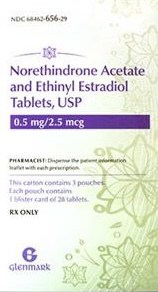
Norethindrone Acetate and Ethinyl estradiol 0.5 mg-2.5 mcg is a combination pill that contains two hormones, ethinyl estradiol (an estrogen) and norethindrone (a progesterone), which are synthetic versions of the hormones naturally produced in a woman's body. Read More
To start hormone replacement therapy using Norethindrone Acetate and Ethinyl Estradiol, it is essential to first consult with a healthcare provider who can evaluate your specific needs and medical history. They will determine if this treatment is suitable for you and provide a prescription with the recommended dosage. Follow the instructions provided by your doctor or health care provider and take the medication at the same time each day to maintain a consistent hormone level in your body.
Norethindrone Acetate and Ethinyl Estradiol can be taken with or without food. Remember to swallow the tablet whole with a glass of water and avoid crushing, chewing, or breaking it. If you happen to miss a dose, take it as soon as you remember, but if it is close to your next dose, skip the missed one and continue with your regular dosing schedule. Do not take a double dose to make up for a missed one.
Regular check-ups with your healthcare provider are essential to monitor your progress and make any necessary adjustments to the treatment. It is important to note that Norethindrone Acetate and Ethinyl Estradiol is typically used for short-term hormonal replacement therapy. If you require long-term treatment, your healthcare provider may consider alternative options. Always remember to follow your healthcare provider’s instructions and seek their guidance throughout the treatment process.
Norethindrone Acetate and Ethinyl Estradiol are the active ingredients in various combination oral contraceptives, commonly known as birth control pills. However, Norethindrone Acetate and Ethinyl Estradiol can also be used as part of menopausal hormone therapy.
In this context, ethinyl estradiol, a synthetic form of estrogen, helps alleviate menopausal symptoms by replacing the declining levels of natural estrogen in the body. Norethindrone, a synthetic form of progesterone, is added to protect the uterus lining from the potential risks of estrogen therapy alone. Together, they provide relief from menopausal symptoms and support overall hormonal balance.
Common side effects include:
It is important to note that the benefits of hormone replacement therapy in managing menopausal symptoms often outweigh the potential risks. However, each individual’s situation is unique, and it is important to discuss the potential risks and benefits with your healthcare provider before starting any medication.
The benefits of Ethinyl Estradiol and Norethindrone combination pills used in hormone replacement therapy for menopause symptoms may include:
There are certain contraindications or situations where the use of Ethinyl Estradiol and Norethindrone may not be recommended.
It is important to note that these are general contraindications, and individual patient factors and medical history should be considered when determining the appropriateness of using ethinyl estradiol and norethindrone. It is always recommended to consult with a healthcare professional for personalized advice.
Personalized Treatments
FREE Delivery & Goodies
Affordable prescription prices
There are no research studies that show Norethindrone Acetate and Ethinyl Estradiol as a cause of weight gain. However, some women might experience water retention when using Norethindrone Acetate and Ethinyl Estradiol. If you are concerned about your weight, talk with a doctor to review your treatment plan.
Yes, Norethindrone Acetate and Ethinyl Estradiol is a combination pill that can be used to prevent pregnancy. This medication comes in different strengths so it’s very important to consult a doctor to be prescribed the right strength to prevent pregnancy and to make sure the medication is safe for your health.
The combination of estradiol and norethindrone is prescribed to alleviate moderate to severe menopausal symptoms such as hot flashes, vaginal problems, and sudden sweating. Additionally, this medication is utilized to prevent osteoporosis following menopause.